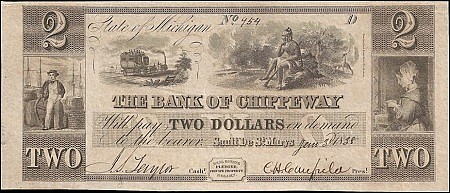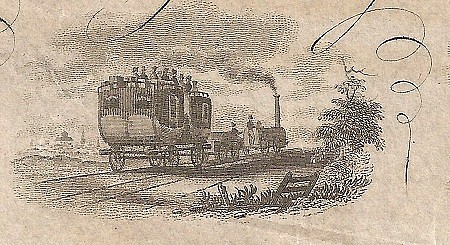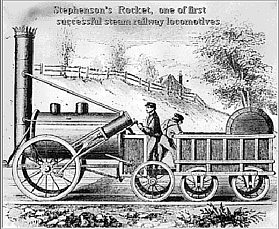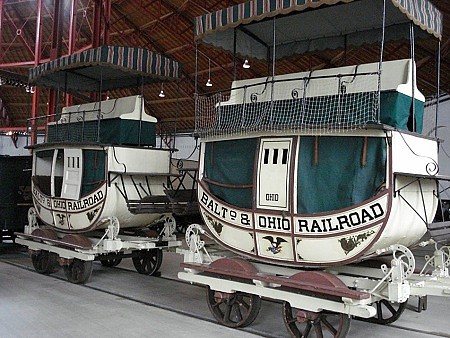MICHIGAN
Bank of Chippeway
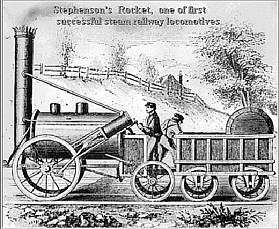
There was a time when there were banknotes issued by private banks. In fact, there are still some countries which allow this, such as Scotland, Northern Ireland, and in China Hong Kong still allows a couple banks to issue notes. In the United States, the issues of banknotes started early on with the Colonies issuing notes, which naturally converted to State issues. As time went on, private banks, railroads, and even businesses were issuing banknotes.
This was all well and good, but there is the inevitable question of what happens when you try to spend a banknote issued from the state of Massachusetts in Georgia? And what happens when a local bank in New Jersey issues a note and you want to go to Chicago? Well you’d want to change your notes over to federal issued notes, or better yet, change them into coins, which were issued federally and were accepted all over. Just because it was a banknote, it wasn’t guaranteed to be worth anything, so the farther you got away from the area, the more your locally issued banknote would be discounted, as the receiver didn’t know the issuer, and to exchange it was a bit of a pain. There was always the chance the issuer wasn’t in business anymore, making the banknotes worthless. But the fact is, most people didn’t travel often, and when they did, they didn’t go too far, so these notes circulated pretty well. Several of these notes exist, with many of them being un-issued remainders that were left in a vault somewhere. Those that were issued are often beat up from use. The types of paper used ranged wildly from thin, almost tissue like paper to more robust papers, but the better the paper, the less the profit, so many were printed on cheap papers.
An example here is a Two Dollar banknote issued in 1838 by the Bank of Chippeway in Sault Ste. Marie (then spelled Sault De St. Marys) in Michigan. The most striking element of this note is that top left vignette with the locomotive. The locomotive is an old Stephenson’s “Rocket” which is shown pulling converted stagecoaches as passenger cars. This new technology embodies a sense of excitement of a new age and a promise of a burgeoning economy. A nice vignette of a Native American, which we can assume is of a Chippewa Indian, shows him seated in deep pastoral contemplation with his rifle. The sailor reminds one that Sault Ste. Marie is in the confluence of the Great Lakes and is at a wonderful site for economic prospects, while the image of the woman at her knitting at right gives one a feeling of warm domesticity. These vignettes are nice, but they are also meant to bring the banknotes bearer and recipient a stronger sense of viability so that the banknote would be accepted elsewhere. The reverse is left blank, as were many banknotes at the time. These types of banknotes are now called Obsoletes and sometimes Wildcat (A reference to the fact that anyone could essentially make their own money). The federal government enacted the National Banknote Act in 1863 placed a 10% tax on all non federal notes. This was much more than the issuers could have made themselves, and as a result, they ceased to be issued or used.
I never thought much about it before, but I can remember seeing the old time steam engines on TV and in movies, which were the stereotypical types seen in most western movies. But they didn’t start out that way. Indeed, there was a transition between the first steam engines and the “4-4-0” found in the old west
As it turns out, there is a massive history concerning railroads, and I simply can’t begin to scratch the surface here, but I’ve listed some of the key dates of major events in railroad history:
- In 1804, the first railroad engine was built in the city of Leeds, England, and ran on wooden rails. This was short-lived and was closely followed by another steam locomotive in Wales. These were mainly cylinders with a pipe hooked to a set of wheels.
- By 1807, again in England, the first passenger train took people from Swansea to Mumbles. These were all nice, but they were primarily experimental and in the very early stages. It was in 1812 that the first commercially successful steam locomotive appeared and ran in Middleton, County Manchester, England.
- In the United States, it wasn’t until 1826 that the first rails were set in the ground in Quincy, Massachusetts. They stretched three miles, but there was no locomotive. It was pulled along by horses. The next year, the B & O Railroad (Baltimore and Ohio) tried putting a sail on the rail cars. This wasn’t as productive as they’d wished, and a horse was then employed to pull the train. Oddly enough, the horse was placed on a treadmill which in turn spun the wheels on the carriage. That horses were used to pull trains sounds odd at first. There doesn’t seem to be a need to have them. But there was a lot less energy needed for a horse to pull on a set of iron rails instead of over a dirt road.
- Finally in 1829 the first steam locomotive was in use in the United States. It was however, built in England. This again was a cylinder with a pipe set upon some wheels, but it could do the job. Except that the engine was too heavy for the rail track and couldn’t be run at all. It was relegated to use as a boiler.
- In 1862, the Pacific Railway Act was enacted and started the first Trans-Continental Railroad, the Central Pacific Railroad. In 1913, the first commercial internal combustion locomotive in the United States ran for the first time.
So, it appears that there was a great deal of experimentation and trials before the romantic steam locomotive started to crisscross the country. This included the passenger cars as well. In the earliest days, there companies simply converted existing stagecoaches, and the result is as you see on this banknote.
